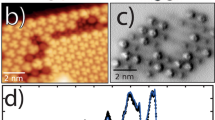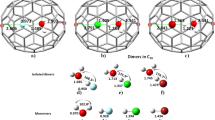Abstract
Fullerene anions and cations have unique structural, electronic, magnetic and chemical properties that make them substantially different from neutral fullerenes. Although much theoretical effort has been devoted to characterizing and predicting their properties, this has been limited to a fraction of isomeric forms, mostly for fullerene anions, and has practically ignored fullerene cations. Here we show that the concepts of cage connectivity and frontier π orbitals allow one to understand the relative stability of charged fullerene isomers without performing elaborate quantum chemistry calculations. The latter is not a trivial matter, as the number of possible isomers for a medium-sized fullerene is many more than 100,000. The model correctly predicts the structures observed experimentally and explains why the isolated pentagon rule is often violated for fullerene anions, but the opposite is found for fullerene cations. These predictions are relevant in fields as diverse as astrophysics, electrochemistry and supramolecular chemistry.
This is a preview of subscription content, access via your institution
Access options
Subscribe to this journal
Receive 12 print issues and online access
$259.00 per year
only $21.58 per issue
Buy this article
- Purchase on Springer Link
- Instant access to full article PDF
Prices may be subject to local taxes which are calculated during checkout



 for the charged fullerene isomers.
for the charged fullerene isomers.

Similar content being viewed by others
References
Martin, N. New challenges in fullerene chemistry. Chem. Commun. 2006, 2093–2104 (2006).
Reed, C. A. & Bolskar, R. D. Discrete fulleride anions and fullerenium cations. Chem. Rev. 100, 1075–1120 (2000).
Lu, X., Feng, L., Akasaka, T. & Nagase, S. Current status and future developments of endohedral metallofullerenes. Chem. Soc. Rev. 41, 7723–7760 (2012).
Popov, A. A., Yang, S. & Dunsch, L. Endohedral fullerenes. Chem. Rev. 113, 5989–6113 (2013).
Rudolf, M. et al. Endohedral metallofullerenes—filled fullerene derivatives towards multifunctional reaction center mimics. Chem. Eur. J. 18, 5136–5148 (2012).
Anilkumar, P. et al. Fullerenes for applications in biology and medicine. Curr. Med. Chem. 18, 2045–2059 (2011).
Iezzi, E. B., Duchamp, J. C., Fletcher, K. R., Glass, T. E. & Dorn, H. C. Lutetium-based trimetallic nitride endohedral metallofullerenes: new contrast agents. Nano Lett. 2, 1187–1190 (2002).
Cagle, D. W., Kennel, S. J., Mirzadeh, S., Alford, J. M. & Wilson, L. J. In vivo studies of fullerene-based materials using endohedral metallofullerene radiotracers. Proc. Natl Acad. Sci. USA 96, 5182–5187 (1999).
Meng, J., Liang, X., Chen, X. & Zhao, Y. Biological characterizations of [Gd@C82(OH)22]n nanoparticles as fullerene derivatives for cancer therapy. Integr. Biol. 5, 43–47 (2013).
McCluskey, D. M. et al. Evidence for singlet-oxygen generation and biocidal activity in photoresponsive metallic nitride fullerene−polymer adhesive films. ACS Appl. Mater. Interfaces 1, 882–887 (2009).
Iwasa, Y. & Takenobu, T. Superconductivity, Mott–Hubbard states, and molecular orbital order in intercalated fullerides. J. Phys. Condens. Matter 15, R495 (2003).
Allemand, P. M. et al. Organic molecular soft ferromagnetism in a fullerene C60 . Science 253, 301–302 (1991).
Wang, Y., Alcamí, M. & Martín, F. in Handbook of Nanophysics Vol. 2 (ed. Sattler, K. D.) Ch. 25, 1–23 (Taylor & Francis, 2010).
Ehrler, O. T., Weber, J. M., Furche, F. & Kappes, M. M. Photoelectron spectroscopy of C84 dianions. Phys. Rev. Lett. 91, 113006 (2003).
Tomita, S. et al. Lifetimes of and dianions in a storage ring. J. Chem. Phys. 124, 024310 (2006).
Wang, X.-B., Woo, H.-K., Huang, X., Kappes, M. M. & Wang, L.-S. Direct experimental probe of the on-site Coulomb repulsion in the doubly charged fullerene anion . Phys. Rev. Lett. 96, 143002 (2006).
Echegoyen, L. & Echegoyen, L. E. Electrochemistry of fullerenes and their derivatives. Acc. Chem. Res. 31, 593–601 (1998).
Cami, J., Bernard-Salas, J., Peeters, E. & Malek, S. E. Detection of C60 and C70 in a young planetary nebula. Science 329, 1180–1182 (2010).
Berné, O., Mulas, G. & Joblin, C. Interstellar . Astron. Astrophys. 550, L4 (2013).
Iglesias-Groth, S. & Esposito, M. A search for near infrared bands of the fullerene cation in the protoplanetary nebula iras 01005+7910. Astrophys. J. 776, L2 (2013).
Bohme, D. K. Multiply-charged ions and interstellar chemistry. Phys. Chem. Chem. Phys. 13, 18253–18263 (2011).
Zettergren, H. et al. Formations of dumbbell C118 and C119 inside clusters of C60 molecules by collision with α particles. Phys. Rev. Lett. 110, 185501 (2013).
Goodman, G., Gershwin, M. E. & Bercovich, D. Fullerene and the origin of life. Isr. Med. Assoc. J. 14, 602–606 (2012).
Bohme, D. K. Buckminsterfullerene cations: new dimensions in gas-phase ion chemistry. Mass Spectrom. Rev. 28, 672–693 (2009).
Campbell, E. E. B., Hansen, K., Heden, M., Kjellberg, M. & Bulgakov, A. V. Ionisation of fullerenes and fullerene clusters using ultrashort laser pulses. Photochem. Photobiol. Sci. 5, 1183–1189 (2006).
Bhardwaj, V. R., Corkum, P. B. & Rayner, D. M. Internal laser-induced dipole force at work in C60 molecule. Phys. Rev. Lett. 91, 203004 (2003).
Reed, C. A., Kim, K.-C., Bolskar, R. D. & Mueller, L. J. Taming superacids: stabilization of the fullerene cations and Science 289, 101–104 (2000).
Bruno, C. et al. Electrochemical generation of and . J. Am. Chem. Soc. 125, 15738–15739 (2003).
Riccò, M. et al. Fullerenium salts: a new class of C60-based compounds. J. Am. Chem. Soc. 132, 2064–2068 (2010).
Bruno, C. et al. Growth of p- and n-dopable films from electrochemically generated C60 cations. J. Am. Chem. Soc. 130, 3788–3796 (2008).
Schon, J. H., Kloc, C. & Batlogg, B. Superconductivity at 52 K in hole-doped C60 . Nature 408, 549–552 (2000).
Fowler, P. W. & Manolopoulos, D. E. Magic numbers and stable structures for fullerenes, fullerides and fullerenium ions. Nature 355, 428–430 (1992).
Fowler, P. & Zerbetto, F. Charging and equilibration of fullerene isomers. Chem. Phys. Lett. 243, 36–41 (1995).
Kroto, H. W. The stability of the fullerenes Cn, with n = 24, 28, 32, 36, 50, 60 and 70. Nature 329, 529–531 (1987).
Campbell, E., Fowler, P., Mitchell, D. & Zerbetto, F. Increasing cost of pentagon adjacency for larger fullerenes. Chem. Phys. Lett. 250, 544–548 (1996).
Albertazzi, E. et al. Pentagon adjacency as a determinant of fullerene stability. Phys. Chem. Chem. Phys. 1, 2913–2918 (1999).
Tan, Y.-Z., Xie, S.-Y., Huang, R.-B. & Zheng, L.-S. The stabilization of fused-pentagon fullerene molecules. Nature Chem. 1, 450–460 (2009).
Martín, N. Fullerene C72Cl4: The exception that proves the rule? Angew. Chem. Int. Ed. 50, 5431–5433 (2011).
Ioffe, I. et al. Chlorination of C86 to C84Cl32 with nonclassical heptagon-containing fullerene cage formed by cage shrinkage. Angew. Chem. Int. Ed. 49, 4784–4787 (2010).
Tan, Y.-Z. et al. Two Ih-symmetry-breaking C60 isomers stabilized by chlorination. Nature Mater. 7, 790–794 (2008).
Popov, A. A. & Dunsch, L. Structure, stability, and cluster-cage interactions in nitride clusterfullerenes M3N@C2n (M=Sc,Y; 2n = 68–98): a density functional theory study. J. Am. Chem. Soc. 129, 11835–11849 (2007).
Zettergren, H., Alcamí, M. & Martín, F. Stable non-IPR C60 and C70 fullerenes containing a uniform distribution of pyrenes and adjacent pentagons. ChemPhysChem 9, 861–866 (2008).
Raghavachari, K. Ground state of C84: two almost isoenergetic isomers. Chem. Phys. Lett. 190, 397–400 (1992).
Rodríguez-Fortea, A., Alegret, N., Balch, A. L. & Poblet, J. M. The maximum pentagon separation rule provides a guideline for the structures of endohedral metallofullerenes. Nature Chem. 2, 955–961 (2010).
Garcia-Borràs, M., Osuna, S., Swart, M., Luis, J. M. & Solà, M. Maximum aromaticity as a guiding principle for the most suitable hosting cages in endohedral metallofullerenes. Angew. Chem. Int. Ed. 52, 9275–9278 (2013).
Elstner, M. et al. Self-consistent-charge density-functional tight-binding method for simulations of complex materials properties. Phys. Rev. B 58, 7260–7268 (1998).
Aradi, B., Hourahine, B. & Frauenheim, T. DFTB+, a sparse matrix-based implementation of the DFTB method. J. Phys. Chem. A 111, 5678 (2007).
Frisch, M. J. et al. Gaussian 09, Revision C.01 (Gaussian, 2010).
Fowler, P. & Manolopoulos, D. E. An Atlas of Fullerenes (Clarendon, 1995).
Chen, N. et al. Sc2S@C2 (7892)-C70: a metallic sulfide cluster inside a non-IPR C70 cage. Chem. Sci. 4, 180–186 (2013).
Stone, A. J. & Wales, D. J. Theoretical studies of icosahedral C60 and some related species. Chem. Phys. Lett. 128, 501–503 (1986).
Yang, H. et al. Isolation and crystallographic identification of four isomers of Sm@C90 . J. Am. Chem. Soc. 133, 6299–6306 (2011).
Acknowledgements
The authors acknowledge the allocation of computer time at the Centro de Computación Científica at the Universidad Autónoma de Madrid (CCC-UAM). This work was supported by MINECO projects FIS2013-42002-R, FIS2013-40667-P and CTQ2013-43698-P, CAM project NANOFRONTMAG-CM (ref. S2013/MIT-2850) and the European COST Action CM1204 XLIC. S.D.-T. acknowledges support from the ‘Ramón y Cajal’ programme.
Author information
Authors and Affiliations
Contributions
Y.W., S.D.-T., M.A. and F.M. conceived and designed the calculations. Y.W. performed the calculations. Y.W., S.D.-T., M.A. and F.M. analysed the data. Y.W. contributed materials/analysis tools. F.M. wrote the paper.
Corresponding author
Ethics declarations
Competing interests
The authors declare no competing financial interests.
Supplementary information
Supplementary information
Supplementary information (PDF 3614 kb)
Rights and permissions
About this article
Cite this article
Wang, Y., Díaz-Tendero, S., Alcamí, M. et al. Cage connectivity and frontier π orbitals govern the relative stability of charged fullerene isomers. Nature Chem 7, 927–934 (2015). https://doi.org/10.1038/nchem.2363
Received:
Accepted:
Published:
Issue Date:
DOI: https://doi.org/10.1038/nchem.2363
This article is cited by
-
Modification of boron nitride nanocages by titanium doping results unexpectedly in exohedral complexes
Nature Communications (2019)
-
Comparing Empty and Filled Fullerene Cages with High-Resolution Trapped Ion Mobility Spectrometry
Journal of the American Society for Mass Spectrometry (2019)
-
Sizes of pentagonal clusters in fullerenes
Journal of Mathematical Chemistry (2017)
-
One rule for the electron-rich...
Nature Chemistry (2015)



